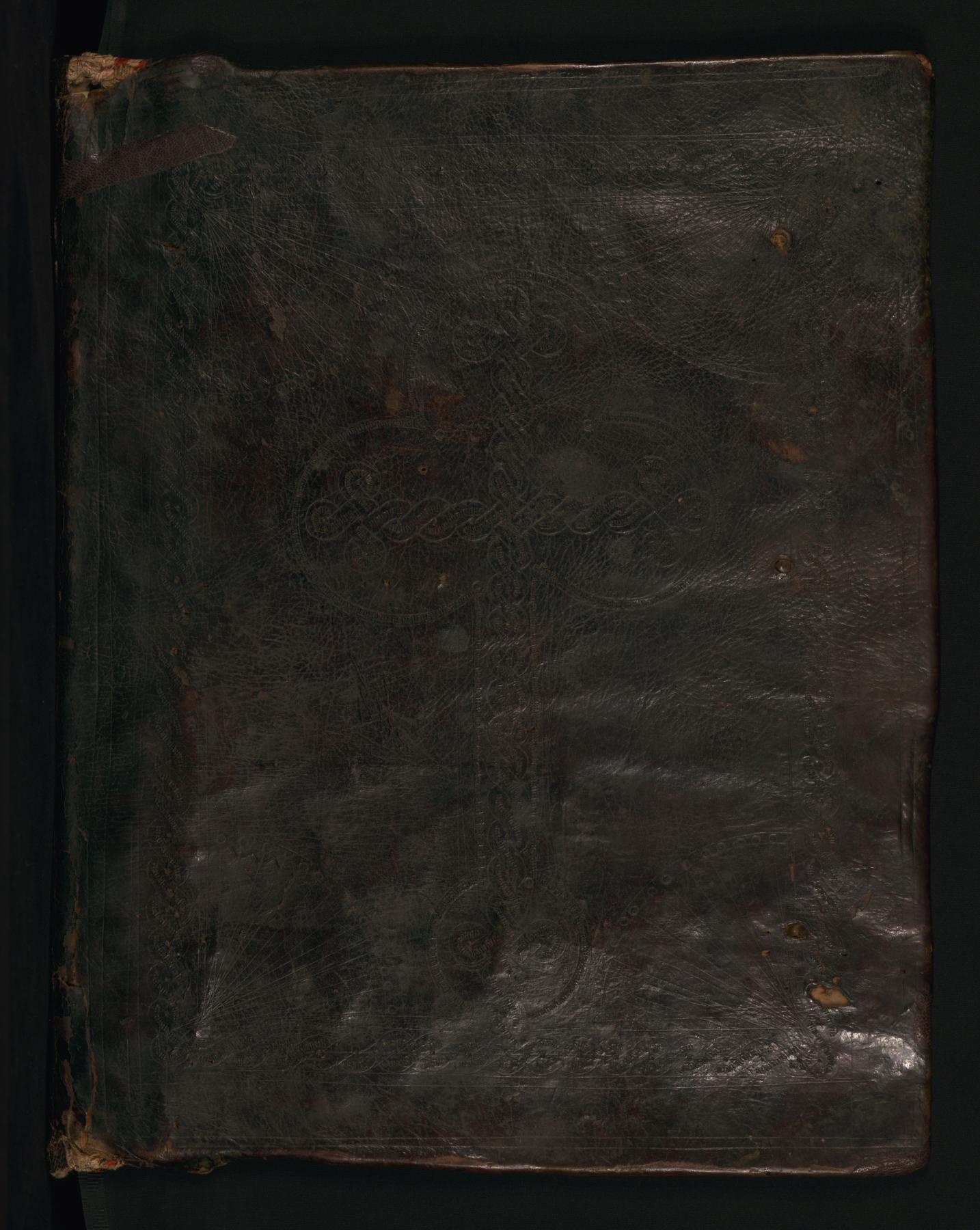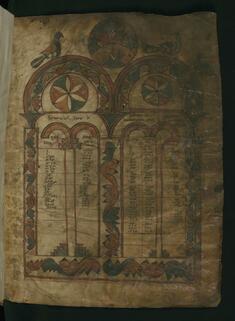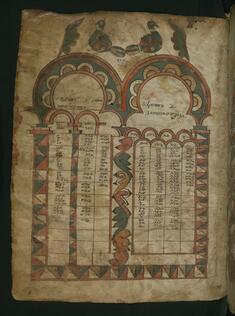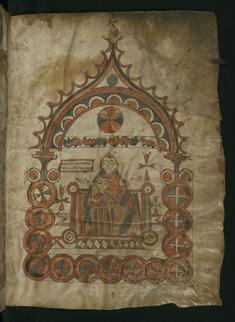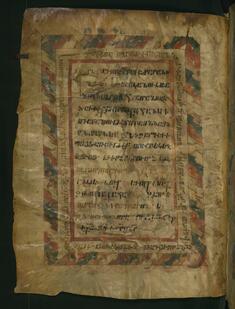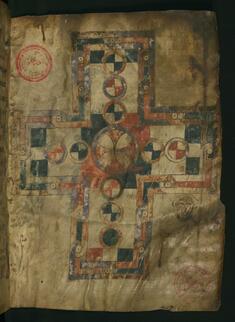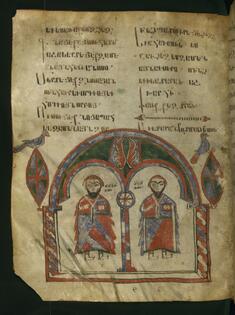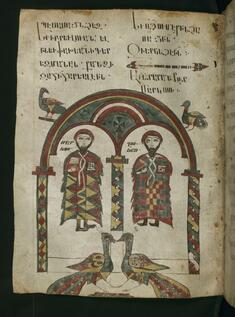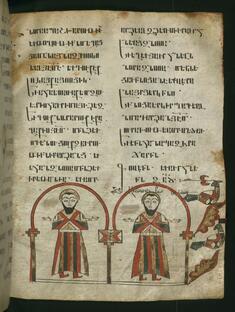Gospels
(Manuscripts and Rare Books, Medieval Europe )
Dated to the tenth century, this manuscript is the oldest Armenian codex in North America and the fifth oldest among documented Armenian Gospel Books. The principal colophon on fol. 2v records that Sargis the Priest completed the text in 415 [966 CE]. Within the framed area, the commission of the codex is described: a priest, whose name was replaced by the later owner Toros, commissioned the work "as decoration and for the splendor of [the] holy church and for the pleasure of the congregation of Rzner." As the codex was written and commissioned by priests, the manuscript is referred to as the Gospels of the Priest. It was formerly known as the Gospels of the Translators, as, following the date 415, someone erased the formula of the Armenian era and replaced it with of our Lord, suggesting an earlier date and implying that the text was based on the original translation of the Gospels into Armenian during the fifth century. The text is copied in large angular erkatagir script. The full-page paintings and marginal ornaments bear stylistic characteristics of Armenian illumination of the tenth and eleventh centuries associated with non-royal patronage. The illustrations comprise the Canon Tables, with only the last two remaining; the Virgin and Child on a wheeled chariot; the framed colophon; ornamental cross with donors portrait; portraits of Mathew and Mark together (fol. 72v, at the end of Matthew) and Mark with Luke (fol. 114v, at the end of Mark); two final images depict unknown saints (fol. 192r, at the end of Luke). Marginalia are found throughout the text. It has been suggested that the scribe was also responsible for the illumination.
Provenance
Provenance (from the French provenir, 'to come from/forth') is the chronology of the ownership, custody, or location of a historical object.
Created by Sargis for the church of Rzner, Armenia (?) [1], 966. Priest Hakob and family, Yerevan, Armenia, 1575, by purchase. Yovhannes Amirxanean, 1839, [location and mode of acquisition unknown]. Hovannes Amirkan, 1843, [location and mode of acquisition unknown]. Yovhannes Amirxaneanc‘, Tabriz, Iran, 1844, [mode of acquisition unknown]. Ala Amirxane Yovhannes Amireanc‘, Nor-Djudha, Armenia (modern Julfa, Azerbaijan), 1844, [mode of acquisition unknown]; Monastery of San Gregorio (St. Gregory), Rome, Italy, 1844, by donation; Monastery of the Antonian Fathers, Ortakeuy, near Istanbul, Türkiye, 1870, by transfer [2]. Henry Walters, Baltimore, [date and mode of acquisition unknown]; Walters Art Museum, 1931, by bequest.
[1] Location not identified.
[2] Seen at the monastery in 1909 by M. Frederic Macler. The location of the manuscript is unknown between 1870 and 1931, and it may have been removed from Armenian territory during the late 19th century Armenian massacres, World War I, or the Armenian Genocide.
Exhibitions
| 2006-2007 | In the Beginning: Bibles Before the Year 1000. Freer Gallery of Art, Washington. |
| 2007 | Armenie: La Magie d'Ecrit. Centre de la Vieille Charité, Marseille. |
| 2004 | Illuminating the Word: Gospel Books in the Middle Ages. The Walters Art Museum, Baltimore. |
| 2001 | Treasures from the Ark: 1700 Years of Armenian Christian Art. British Library, London. |
| 1994 | Treasures in Heaven: Armenian Illuminated Manuscripts. The Morgan Library & Museum, New York; The Walters Art Gallery, Baltimore. |
| 1988 | Treasures in Heaven: Armenian Manuscript Illumination. The Walters Art Gallery, Baltimore. |
| 1984-1985 | Illuminated Manuscripts: Masterpieces in Miniature. The Walters Art Gallery, Baltimore. |
| 1968 | In Remembrance of Creation: Evolution of Art and Scholarship in the Medieval and Renaissance Bible. Brandeis University Library, Waltham. |
| 1947 | Early Christian and Byzantine Art. Baltimore Museum of Art, Baltimore. |
| 1953-1957 | 4000 Years of Modern Art. The Walters Art Gallery, Baltimore; Baltimore Museum of Art, Baltimore. |
Geographies
Armenia (Place of Origin)
Measurements
Overall H: 12 13/16 x W: 10 1/16 x D: 3 3/4 in. (32.5 x 25.5 x 9.5 cm); Folio H: 12 × W: 9 13/16 in. (30.5 × 25 cm)
Credit Line
Acquired by Henry Walters
Location in Museum
Not on view
Accession Number
In libraries, galleries, museums, and archives, an accession number is a unique identifier assigned to each object in the collection.
In libraries, galleries, museums, and archives, an accession number is a unique identifier assigned to each object in the collection.
W.537

